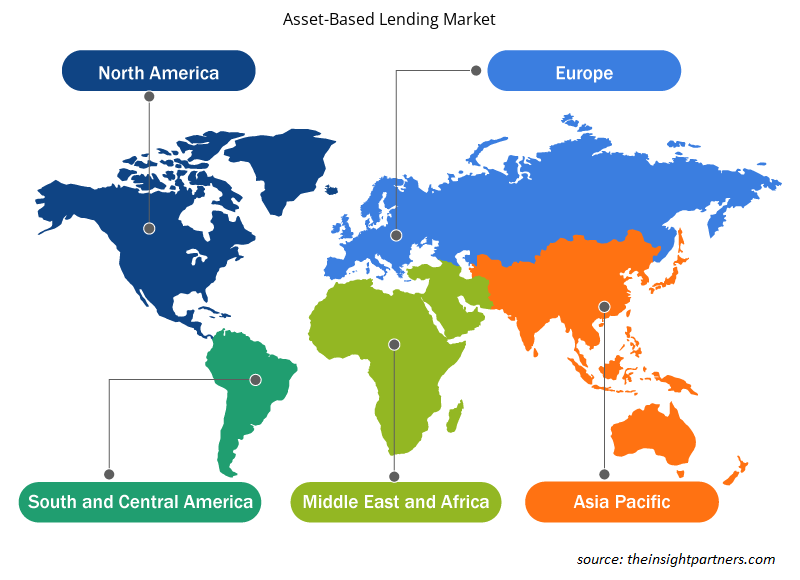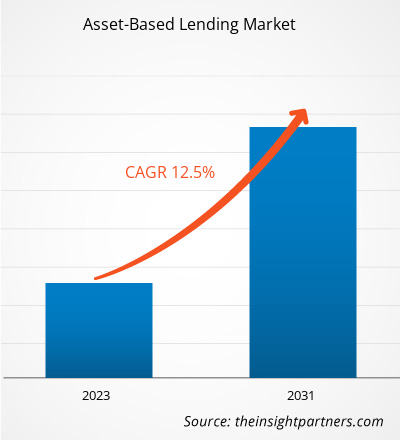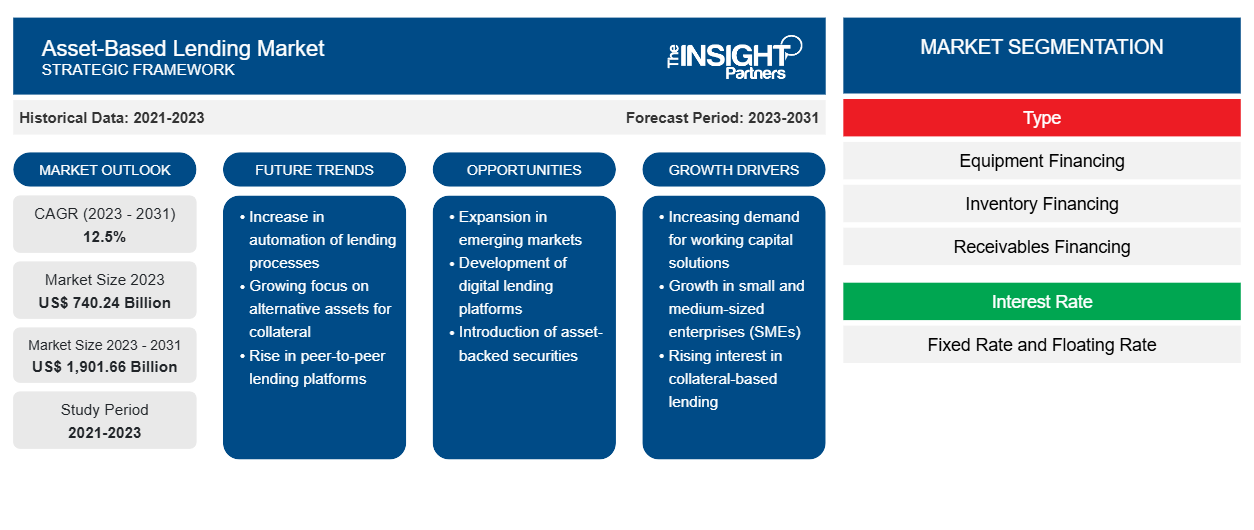자산 기반 대출 시장 규모는 2023년 7,402억 4,000만 달러에서 2031년 1,9016억 6,000만 달러로 성장할 것으로 예상되며, 2023년에서 2031년까지 연평균 성장률 12.5%로 확대될 것으로 예상됩니다. 자산 기반 대출에 대한 자격 기준이 간소화되면 높은 성장 기회가 제공될 것으로 예상됩니다.
자산 기반 대출 시장 분석
자산 기반 대출은 경제의 여러 다른 부문에 걸쳐 있는 대규모 자산 클래스입니다. 전통적인 은행 자금 조달과 기술 혁신의 지속적인 중개 해제는 최근 몇 년 동안 급속한 성장을 촉진했으며 이러한 추세는 계속될 것으로 예상됩니다. 회사의 현금 흐름을 평가하는 전통적인 비즈니스 자금 조달은 많은 기업에 효과적입니다. 그러나 일부 회사는 소유 자산을 기반으로 추가 차입을 받을 자격이 있을 수 있습니다. 자산 기반 대출이라고 하는 이러한 대안적 접근 방식이 이러한 기업에 더 적합합니다. 자산 기반 대출 시장 솔루션을 사용하면 매출채권, 브랜드 이름, 부동산 및 지적 재산을 포함한 광범위한 자산을 담보로 사용하여 중요한 자본에 대한 접근성을 제공할 수 있습니다. 상당한 자산을 보유한 기업의 경우 자산 기반 대출은 미래의 의사 결정을 허용하는 유연한 구조로 상당한 자금 조달 옵션을 제공합니다. 또한 FILO(선입, 후출) 트랜치와 같은 특별한 약정은 차입 용량을 늘릴 수 있습니다.
자산 기반 대출
산업 개요
- 대출 기관은 대출인이 지불을 이행하지 않을 때를 대비해 현금으로 쉽게 전환할 수 있는 증권과 같은 유동성이 높은 담보를 선호합니다. 물리적 자산에 대한 대출은 더 위험한 것으로 간주되므로 최대 대출 금액은 종종 자산의 장부 가치보다 적습니다.
- 신청자의 신용 기록, 사업 기간 및 현금 흐름에 따라 이자율에 큰 차이가 있습니다. 자산 기반 대출이 생성하는 담보 기반 현금 흐름은 높은 인플레이션과 거시경제적 불확실성의 시기에도 중요합니다. 기본 담보는 유형적 가치를 가지고 있으며, 해당 담보에 부가된 현금 흐름은 종종 계약적 성격을 띱니다.
- 게다가 실물 담보의 대체 가치는 전체 경제의 가격과 함께 상승하는 경향이 있습니다.
귀하의 요구 사항에 맞게 이 보고서를 사용자 정의하세요
이 보고서의 일부 또는 국가 수준 분석, Excel 데이터 팩을 포함하여 모든 보고서에 대한 사용자 정의를 무료로 받을 수 있으며 신생 기업 및 대학을 위한 훌륭한 혜택과 할인 혜택을 이용할 수 있습니다.
-
이 보고서의 주요 시장 동향을 알아보세요.이 무료 샘플에는 시장 동향부터 추정 및 예측까지 다양한 데이터 분석이 포함됩니다.
자산 기반 대출 시장 동인 및 기회
자산 기반 대출 시장 성장을 주도할 민간 자산 기반 대출
- 세계 금융 위기의 결과로 민간 자산 기반 대출이 급증한 눈에 띄는 속도는 지속적인 구조적 변화의 신호로 볼 수 있습니다.
- 전통적인 금융 채널의 중개 해제는 지난 몇 년 동안 민간 자산 기반 대출의 성장에 중요한 역할을 했습니다. 금융 위기 이후, 여러 선진국의 중앙은행은 시장에 유동성을 주입하고 신뢰를 회복하기 위해 모기지 담보 증권을 매수했으며, 동시에 준비금 요건을 높이고 위험 감수를 단속했습니다. 이로 인해 비주류 대출에 더 높은 자본 비용이 부과되었습니다.
- 은행들은 대출 금액을 낮추고 오랜 고객들에게 일상적인 조건으로 신용을 확대함으로써 대응했습니다. 이로 인해 신용이 좋은 몇몇 소비자들에게 자금이 공급되지 않게 되었고, 결과적으로 사적 자산 기반 대출에 대한 수요가 증가했습니다.
- 지속적인 경제적 혼란 속에서 위에 언급된 추세는 자산 기반 대출 시장 성장에 좋은 기회를 제공할 것으로 예상됩니다.
자산 기반 대출
시장 보고서 세분화 분석
- 시장은 이자율을 기준으로 고정 이자율과 변동 이자율로 나뉩니다.
- 고정금리 세그먼트는 2023년에 가장 높은 자산 기반 대출 시장 점유율을 달성했습니다. 이는 고정금리 대출의 주요 이점인 금리가 급등할 때 예상치 못한 큰 월 상환금 증가로부터 차용인을 보호하는 데 기인할 수 있습니다. 게다가 고정금리 대출은 쉽게 이해할 수 있으며 대출 기관 간의 차이가 적습니다.
자산 기반 대출
지역별 시장 점유율 분석
자산 기반 대출 시장 보고서의 범위는 주로 북미, 유럽, 아시아 태평양, 중동 및 아프리카, 남미의 5개 지역으로 나뉩니다. 아시아 태평양(APAC)은 급속한 성장을 경험하고 있지만 북미가 가장 큰 자산 기반 대출 시장 점유율을 차지할 것으로 예상됩니다. APAC의 상당한 경제 발전과 거래에 대한 관심 증가는 자산 기반 대출이 확장될 수 있는 상당한 기회를 제공했습니다. 미국에서 비은행 대출 기관은 담보로 사용 가능한 자산의 20% 이상에 대해 자산 기반 대출을 확대했습니다. 이러한 추세는 북미의 시장 성장을 촉진합니다.
자산 기반 대출
자산 기반 대출 시장 지역 통찰력
Insight Partners의 분석가들은 예측 기간 동안 자산 기반 대출 시장에 영향을 미치는 지역적 추세와 요인을 철저히 설명했습니다. 이 섹션에서는 북미, 유럽, 아시아 태평양, 중동 및 아프리카, 남미 및 중미의 자산 기반 대출 시장 세그먼트와 지리적 분포도 논의합니다.

- 자산 기반 대출 시장에 대한 지역별 특정 데이터 얻기
자산 기반 대출 시장 보고서 범위
| 보고서 속성 | 세부 |
|---|---|
| 2023년 시장 규모 | 7402억 4천만 달러 |
| 2031년까지 시장 규모 | 1조 9,016억 6,000만 달러 |
| 글로벌 CAGR (2023-2031) | 12.5% |
| 역사적 데이터 | 2021-2023 |
| 예측 기간 | 2023-2031 |
| 다루는 세그먼트 |
유형별로
|
| 포함된 지역 및 국가 |
북아메리카
|
| 시장 선도 기업 및 주요 회사 프로필 |
|
자산 기반 대출 시장 참여자 밀도: 비즈니스 역학에 미치는 영향 이해
자산 기반 대출 시장 시장은 소비자 선호도의 변화, 기술 발전, 제품의 이점에 대한 인식 증가와 같은 요인으로 인해 최종 사용자 수요가 증가함에 따라 빠르게 성장하고 있습니다. 수요가 증가함에 따라 기업은 제품을 확장하고, 소비자의 요구를 충족하기 위해 혁신하고, 새로운 트렌드를 활용하여 시장 성장을 더욱 촉진하고 있습니다.
시장 참여자 밀도는 특정 시장이나 산업 내에서 운영되는 회사나 기업의 분포를 말합니다. 주어진 시장 공간에 얼마나 많은 경쟁자(시장 참여자)가 존재하는지 그 규모나 총 시장 가치에 비해 나타냅니다.
자산 기반 대출 시장에서 운영되는 주요 회사는 다음과 같습니다.
- 바클레이스 은행
- 버크셔 은행
- 자본금 조달 솔루션
- 크리스탈 파이낸셜
- 힐튼-베어드
면책 조항 : 위에 나열된 회사는 어떤 특별한 순서에 따라 순위가 매겨지지 않았습니다.

- 자산 기반 대출 시장의 주요 참여자 개요를 알아보세요
"자산 기반 대출 시장 분석"유형, 이자율, 조직 규모, 지리적 위치를 기준으로 수행되었습니다. 유형 측면에서 시장은 장비 자금 조달, 재고 자금 조달, 미수금 자금 조달 및 기타로 세분화됩니다. 이자율에 따라 시장은 고정 금리와 변동 금리로 나뉩니다. 조직 규모 측면에서 시장은 중소기업과 대기업으로 나뉩니다. 지리적 위치를 기준으로 시장은 북미, 유럽, 아시아 태평양, 중동 및 아프리카, 남미로 세분화됩니다.
자산 기반 대출
시장 뉴스 및 최근 개발 사항
회사는 자산 기반 대출 시장에서 합병 및 인수와 같은 무기적 및 유기적 전략을 채택합니다. 최근 몇 가지 주요 시장 개발은 다음과 같습니다.
- 2024년 3월, Praetura Commercial Finance는 자매 회사인 Zodeq와 함께 Barclays가 영국 전역의 중소기업 지원을 강화하기 위해 제공한 2억 파운드 자산 기반 대출 담보화 시설을 확보했습니다. Barclays 시설은 Praetura가 대체 대출에 대한 수요 증가에 대처할 수 있는 능력을 강화하며, 이 회사는 매년 1,000개 이상의 추가 중소기업을 지원할 것으로 예상합니다.
[출처: Praetura Commercial Finance, 회사 웹사이트]
- 2023년 10월, 담보 금융을 위한 글로벌 핀테크 소프트웨어 파트너인 Solifi는 Solifi 자산 기반 대출에 대한 최신 제품 개선 사항을 발표했습니다. 이 릴리스에는 자동화, 보고 및 고객 경험을 통해 효율성을 개선하는 것을 목표로 하는 여러 가지 새로운 기능이 포함되어 있습니다. 이 회사의 SaaS Open Finance Platform은 대출자와 차용자 간의 커뮤니케이션을 개선하는 새로운 기능을 신속하게 릴리스할 수 있도록 합니다. 이러한 새로운 기능은 수동 보고 요구 사항을 줄이는 동시에 회사의 자산 기반 대출 및 채권 금융 대출자와 고객에게 비즈니스를 중단하지 않고 혁신을 제공합니다.
[출처: Solifi, 회사 홈페이지]
자산 기반 대출
시장 보고서 범위 및 제공물
"자산 기반 대출 시장 규모 및 예측(2021-2031)"에 대한 시장 보고서는 아래 영역을 포괄하는 시장에 대한 자세한 분석을 제공합니다.
- 범위에 포함된 모든 주요 시장 부문에 대한 글로벌, 지역 및 국가 수준의 시장 규모와 예측입니다.
- 시장 역학에는 동인, 제약, 주요 기회 등이 있습니다.
- 주요 미래 트렌드
- 자세한 PEST 및 SWOT 분석
- 주요 시장 동향, 주요 업체, 규정, 최근 시장 개발 사항을 다루는 글로벌 및 지역 시장 분석입니다.
- 시장 집중도, 히트맵 분석, 주요 업체 및 최근 개발 사항을 포괄하는 업계 환경 및 경쟁 분석입니다.
- 자세한 회사 프로필
- 과거 분석(2년), 기준 연도, CAGR을 포함한 예측(7년)
- PEST 및 SWOT 분석
- 시장 규모 가치/거래량 - 글로벌, 지역, 국가
- 산업 및 경쟁 환경
- Excel 데이터세트
최근 보고서
사용 후기
구매 이유
- 정보에 기반한 의사 결정
- 시장 역학 이해
- 경쟁 분석
- 고객 인사이트
- 시장 예측
- 위험 완화
- 전략 기획
- 투자 타당성 분석
- 신흥 시장 파악
- 마케팅 전략 강화
- 운영 효율성 향상
- 규제 동향에 발맞춰 대응























 무료 샘플 받기 - 자산 기반 대출 시장
무료 샘플 받기 - 자산 기반 대출 시장